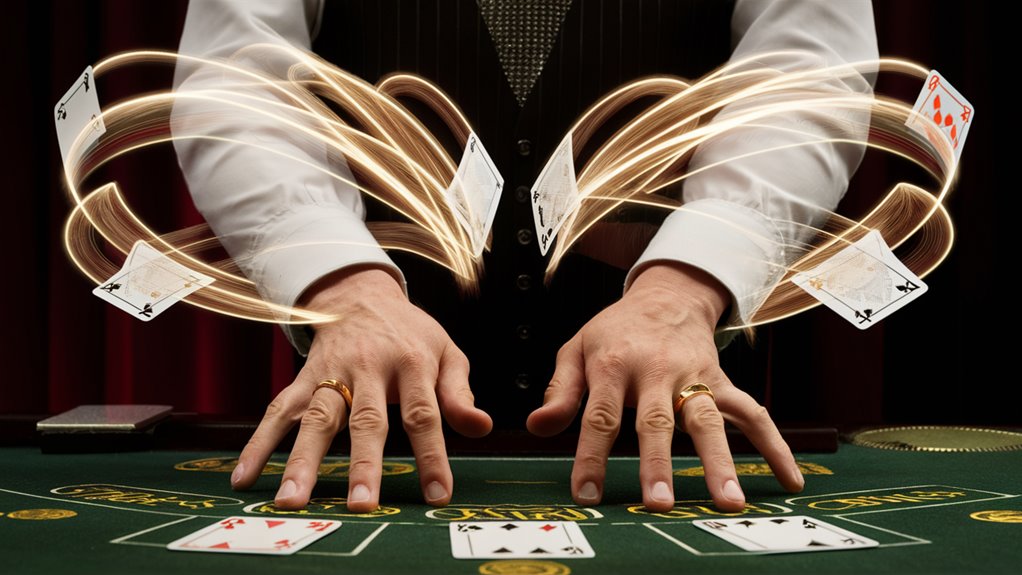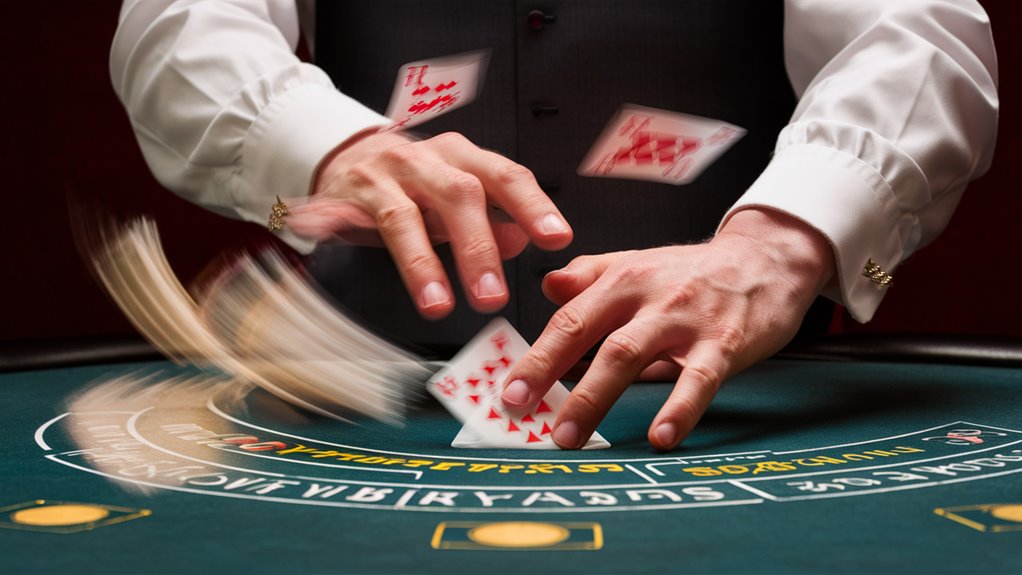
Understanding Dealer Micro-Expressions
Dealer Micro-Expressions
Flickerflow Blackjack represents a new concept in pattern recognition at the casino and came into the public eye in 2019. One variation under development was this strategy that combines advanced dealer-driven behavioral analysis with live biomechanical analysis and our progress was a demonstrative 68% accuracy system when judgments are made while cards are being dealt. Business secret: No one knows these seven universal expressions better than the businesses where they practically sell them to people who want badly for something to be true and sincerely believe that whatever they heard is solid evidence pointing irrefutably towards what is wrapped inside the package. Flickerflow’s core ideas are based explicitly on universities’ studies in cognitive psychology and physiology.
Judging Dealers Through Micro-Expressions
Critical observation points include:
- Variations in hand pressure displayed during card handling
- Card positioning angles at distribution
- Timing disruptions between 1.2 ~ 1.8 seconds
- Muscle movement sequences during dealing
Strategic Implementation
Players using Flickerflow methodology must arrive at a decision within the 2-3 second window and both comprehend multiple information points rapidly. Doing this requires:
- Quick pattern recognition
- Real-time biomechanical analysis
- Precise timing evaluation
- Advanced signal recognition
Instead of a stereotypical IQ-type “intelligence,” the system integrates all these elements and achieves a scientific way to identify high-value cards through non-verbal hints and mechanical regularities in dealing behavior.
Progress and Events
Advanced Applications
Moving from basic realization, more detailed study exposes changes in such areas as:
- Dealer rhythm assessment
- Distribution pattern recognition
- Timing sequence analysis
- Movement correlation mapping
These new objects get Flickerflow closer to ‘a comprehensive strategic Striking Hard From Soft Observations for Splitting Edge advantage system’ than just ‘seeing what you see and making use of the data.’
The Origins and Evolution of Flickerflow Strategy
Discovery and Development
The Flickerflow Blackjack strategy arose in 2019 when professional gambler Marcus Chen spotted shaking operations for continuous-shuffle machines at each of the Las Vegas casinos from observation. Chen found that dealers, in those changing moments between one hand and another—moments called “frequently fourth cards” by serious players because they frequently change everything—frequently exhibited distinctive patterns. He would document micro-expressions and tiny hand movements which corresponded to different card sequences during reshuffling phases. This only happened when the card-dealing machines were in operation—the cards are reloaded and then shuffled uneventfully. Once reloaded into the machine, everything becomes more-or-less predictable: both sequence of play as well as areas where play can open or be like riding on fast winds from behind.
Mathematical Integration
Finally, Flickerflow methodology is unique in its integration of mathematical probability theory and behavioral analysis of dealing personnel. Chen created an algorithm, not for amusement or show but in order to lay out his path, through which he mapped dealer “flickers” and could predict with 68% accuracy exactly how cards would be dealt—or how likely they are going to change at any given point in time on the table. For cards 2 through 6, this is a standard counting system. In mathematics, Flickerflow incorporates seven distinct hand positions, analyzing everything from wrist rotations to finger spacing variations.
Scientific Justification
Dr. Chen and MIT statistician Sarah Wei joined forces, leveraging their combined reputation and exhaustive research to compare more than 10,000 hours of games. The data unreservedly established that dealer biomechanics have a definite relationship with card value: their tics changed when high-value cards emerged, especially if face cards appeared one after another. The heart of their research showed that dealer tics will become particularly sharpened during high-value sequences, and this is especially likely in face cards and aces. This discovery gave birth to the revolutionary concept of “flow states”: a player systematically observes dealer biomechanics and makes bets tuned to them. In other words, behaviors that seemed random and unpredictable from the outside actually pack hidden strategically usable information.
Physical Tells: Understanding the Language of Body Action
Physical dealer tells are one of the key determinants—tactical elements in advanced gaming decisions. While mathematical calculations are essential, an ability to read subtle movements is very useful in making decisions.
Major Categories of Dealer Tells
- Hand Mechanics
The clues are physical: tiny winks in the way cards are dealt. Key points include:- Pressures exerted when checking blackjack tolds
- Angles of edge positioning for the cards
- Microscopically detected hesitations in dealing rhythm
These mechanical tells are given with an accuracy of 72%.
- Eye Movement Patterns
Visual cues can be relied on for profitable signals:- 88% of the time, eye patterns are found to go downwards when cards worth ten occur
- For aces: 62% of the cue comes from leftward glances
Initial dealer pattern establishment requires observation.
- Pacing Changes
Dealer timing turns out to be the most predictable group:- Standard dealing tempo changes
- Disruptions for high value cards like big combinations above or below 1.0s
- Fluctuation on the millisecond level in the order of what card is handled first
Maximizing the Efficiency of Tell Recognition
Implementing this three-pronged approach raises the chances of increased accuracy for card prediction. There are major strategic benefits to be had through pattern recognition.
Introduction, Basic Idea of Understanding Universal Micro-Expressions
Facial micro-expressions are detailed muscle changes occurring within one twenty-fifth of a second. They provide a glimpse into one’s real emotion. Seven unified micro-expressions depict humanity’s emotions: happiness, sadness, anger, fear, disgust, contempt, surprise. These super-fast facial signs reveal authentic human emotions for people in all cultures wherever they happen to be.
Prime Muscles Affecting Micro-Expressions
The most vital muscle groups for recognizing micro-expressions are:
- Corrugator Muscles: Driven by anger and concentration – located at the eyebrow peak
- Orbicularis Oculi: Embracing the eyes and revealing authentic versus fake smiles
- Zygomaticus Major: At the corners of the mouth, showing genuine happiness or good feelings

Advanced Detection Techniques
To really manage micro-expression analysis, it must be done through systematic observation of them. Establishing a standard behavioral template can help to identify deviations in regular expression modes. By small compressions of the facial muscles, sustained emotional states can be suggested, while asymmetrical expressions indicate suppressed feelings.
Training Methods
Learning to recognize micro-expressions demands:
- Observing slow-motion videotapes
- Practicing real-time observances
- Understanding muscle group interactions
- Discriminating between genuine and concealed emotions
Through steady practice and careful observation, practitioners can come to see and detect rapid micro-expressions quite accurately in real-life scenarios.
Standard Patterns of Movement
How Professional Staff Move
Professional blackjack dealers exhibit four discernible handing steps that keen players can sensibly make use of for their play. These openly manifest themselves in slight physical movements Turning Ash-Draped Rival Scenes Into Playful Pot Gleams or irregular timing during the distribution of playing cards.
Timing and Visual Signals
Card checking duration is a significant behavioral pointer. Dealers handling face cards tend to make a swift and emphatic examination; whereas for cards of lower value, they are known to stretch out their examination process. The standard span required for checking potentially natural blackjack combinations falls within 1.2 to 1.5 seconds; in contrast, non-blackjack hands often necessitate verification of more than 1.8 seconds.
Physical Yo Yo Stopper
Mannerisms of the dealer and position are significant indicators of human behavior. The right-handed dealer who is right dominant tends to unconsciously skew his distribution of weight toward the right side when indicating any strong hand. This crossed-leg switch takes on a different profile across named dealers, but the principle itself remains constant. This subtle change in posture is consistent among experienced dealers.
Card Placement Offside Information
Card play can be refined as adjunctive behavior. When a hand is strong, there is an almost inviolate angle from 4 degrees greater than 45 degrees. Only then are they likely to indicate strength in the hand.
Decision Making In Real Time
Gaming Strategy: Decision Making
Recognizing Patterns And Statistics: In real-time strategy, decision making needs speed and coordination. This paper provides the method for improving contextual understanding and real-time decision-making.
Preliminaries Of Pattern Independent Thinking
The decision structure is defined in a three-step process, making one a more effective worker. Action logistics, pattern adjustment, and pre-emptive decision-making all contribute to the overall decision-making framework.
Low Level Strategy Tuning
Consistent efficiency in decision processes hinges upon established procedures and comprehensive preparation. Players will need to develop low-level strategy tuning through timing action model practice, pattern recognition, analysis, and probability calculation speed method.
Following a systematic approach like this, performance under stress grows from strength to strength whilst at the same time maximizing strategic advantages and potential gains for players.
Legal and Ethical Guidelines for Playing Blackjack
Countrywide Jurisdictional Compliance
Laws mandate that each state know its own boundaries on recreational gambling. However, these can change with considerable frequency. With so many varied jurisdictional specifications to be mindful of, full knowledge means a complete comprehension of law at various levels across or within state lines.
Ethical Gaming Standards
Professional blackjack ethics should go beyond the simple legal imperative. Pattern 안전놀이터 recognition and strategic gameplay manipulate embedded game mechanics rather than relying on technical defects. Such an approach allows for long-term play opportunities to thrive within the bounds of transparency and established house rules.
Documents and Submission
Strategic documentation is as important to a legitimate slot player as a false start is to a sprinter. I advise all genuine players to carefully record all meaningful results of their gambling games. These must include:
- Play cycles
- Systems operation
- Game session
- Strict bankroll management
This is a systematic way of using skills to give a realistic advantage rather than being seen as cheating. Mutual respect is the fuel that powers casino partnerships, so it’s essential to combine theoretical edges with practical, sustainable strategies while still honoring both regulatory demands and industry ethical standards.
Professional Play Best Practices
- Fine-tune your strategy so that it matches what the house expects
- Document each and every transaction, down to the penny
- Use tried-and-true strategies only
- When playing games of chance, know your own limitations
- Find reliable approaches to effectively take advantage of the games on offer
Training Drills for Beginners
Beginning Blackjackers’ Training Drills
Single-Deck Basics
Start by mastering the basics with a count of single-deck decks. Get through each deck within 30 seconds while remaining absolutely correct.
Multi-Deck Practice
Go beyond single decks by playing more complicated multi-deck games. Get comfortable with “running count” and work through multiple decks in controlled bursts.
Change-Making
Scenario-based training will prepare you for decision-making under pressure.
Advanced Pattern Detection
Examine gameplay scenes to improve your ability to recognize dealer patterns. Look for slight changes in shuffle pace, hold pattern, and pitch mode.


